Business Finance Report: Analysis of Australian Financial Market
VerifiedAdded on 2021/02/21
|16
|3452
|26
Report
AI Summary
This report provides a comprehensive analysis of the Australian financial market, focusing on investment options for overseas investors. It examines the market structure, including various sectors, regulators, and types of markets, as well as the sources of financial information. The report delves into capital budgeting tools such as NPV, IRR, ARR, and payback period, outlining their rationale, decision rules, and advantages/disadvantages. It also analyzes the Australian bond and share markets, including bond ratings, government vs. corporate bonds, and the relationship between coupon rate and yield to maturity. The report identifies potential industries for financial investment, providing market capitalization data and historical trends. Finally, it offers recommendations for investment in the Australian market, leveraging financial statements, market indices, and company information to guide effective decision-making. This report is available on Desklib, a platform offering valuable resources for students.
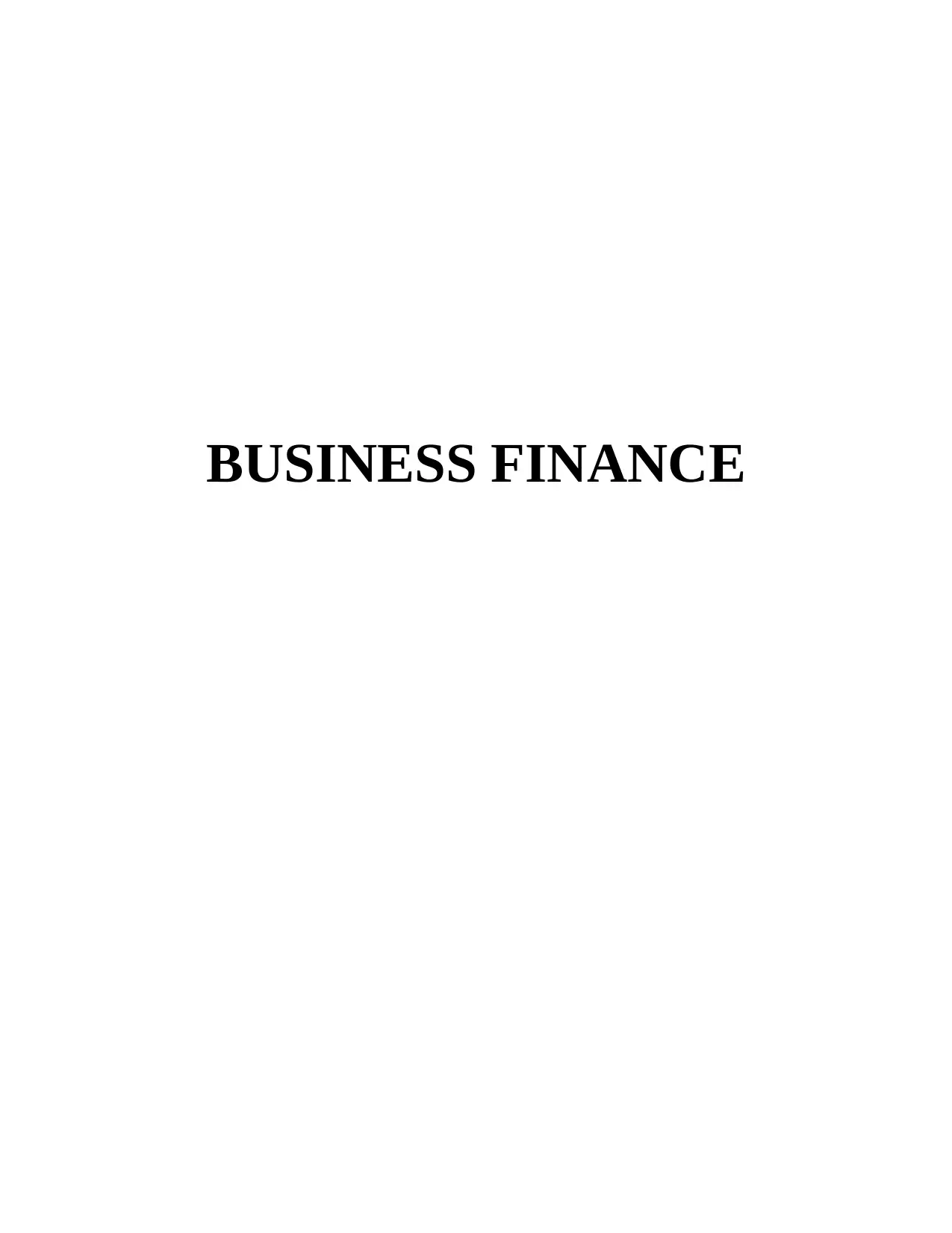
BUSINESS FINANCE
Paraphrase This Document
Need a fresh take? Get an instant paraphrase of this document with our AI Paraphraser
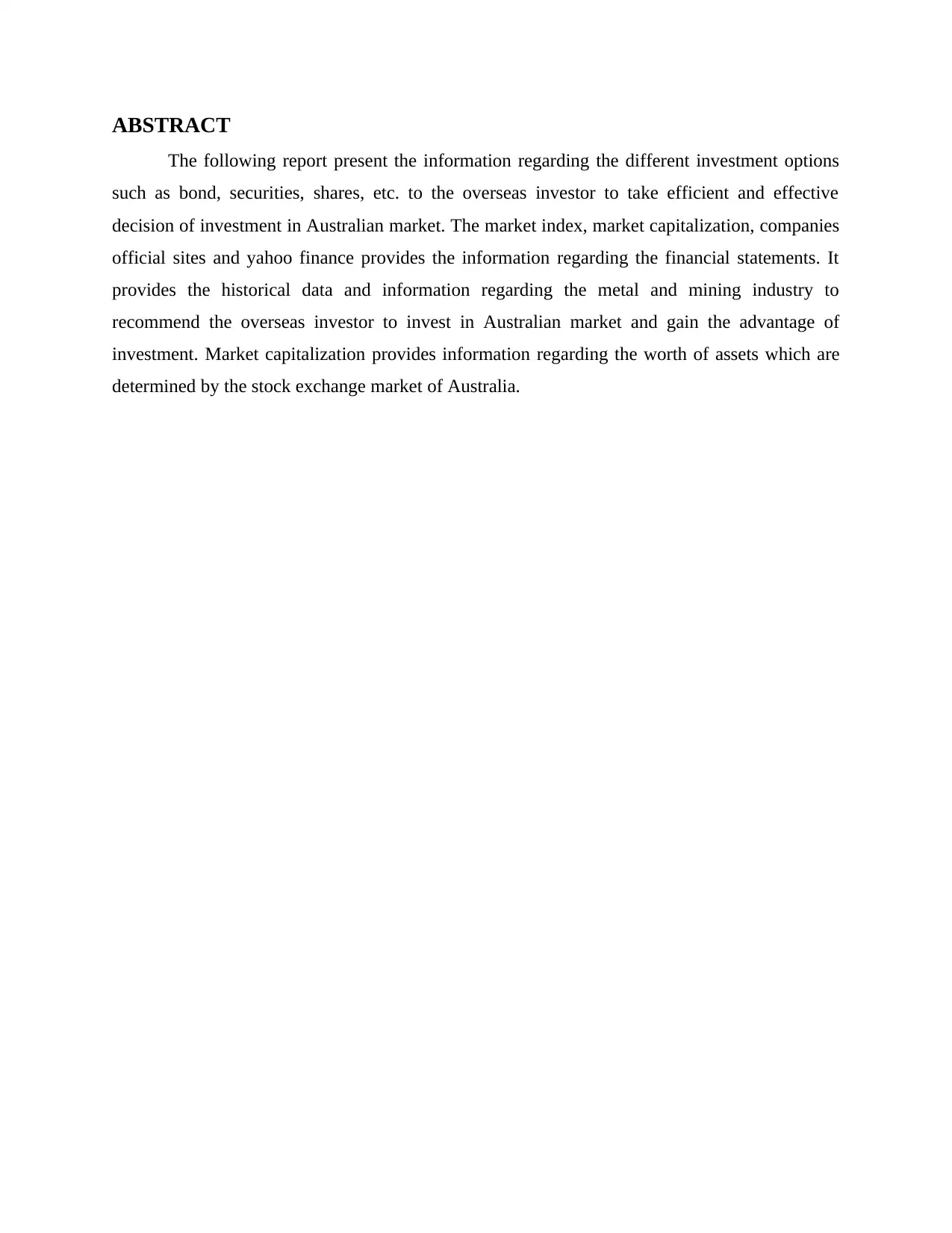
ABSTRACT
The following report present the information regarding the different investment options
such as bond, securities, shares, etc. to the overseas investor to take efficient and effective
decision of investment in Australian market. The market index, market capitalization, companies
official sites and yahoo finance provides the information regarding the financial statements. It
provides the historical data and information regarding the metal and mining industry to
recommend the overseas investor to invest in Australian market and gain the advantage of
investment. Market capitalization provides information regarding the worth of assets which are
determined by the stock exchange market of Australia.
The following report present the information regarding the different investment options
such as bond, securities, shares, etc. to the overseas investor to take efficient and effective
decision of investment in Australian market. The market index, market capitalization, companies
official sites and yahoo finance provides the information regarding the financial statements. It
provides the historical data and information regarding the metal and mining industry to
recommend the overseas investor to invest in Australian market and gain the advantage of
investment. Market capitalization provides information regarding the worth of assets which are
determined by the stock exchange market of Australia.
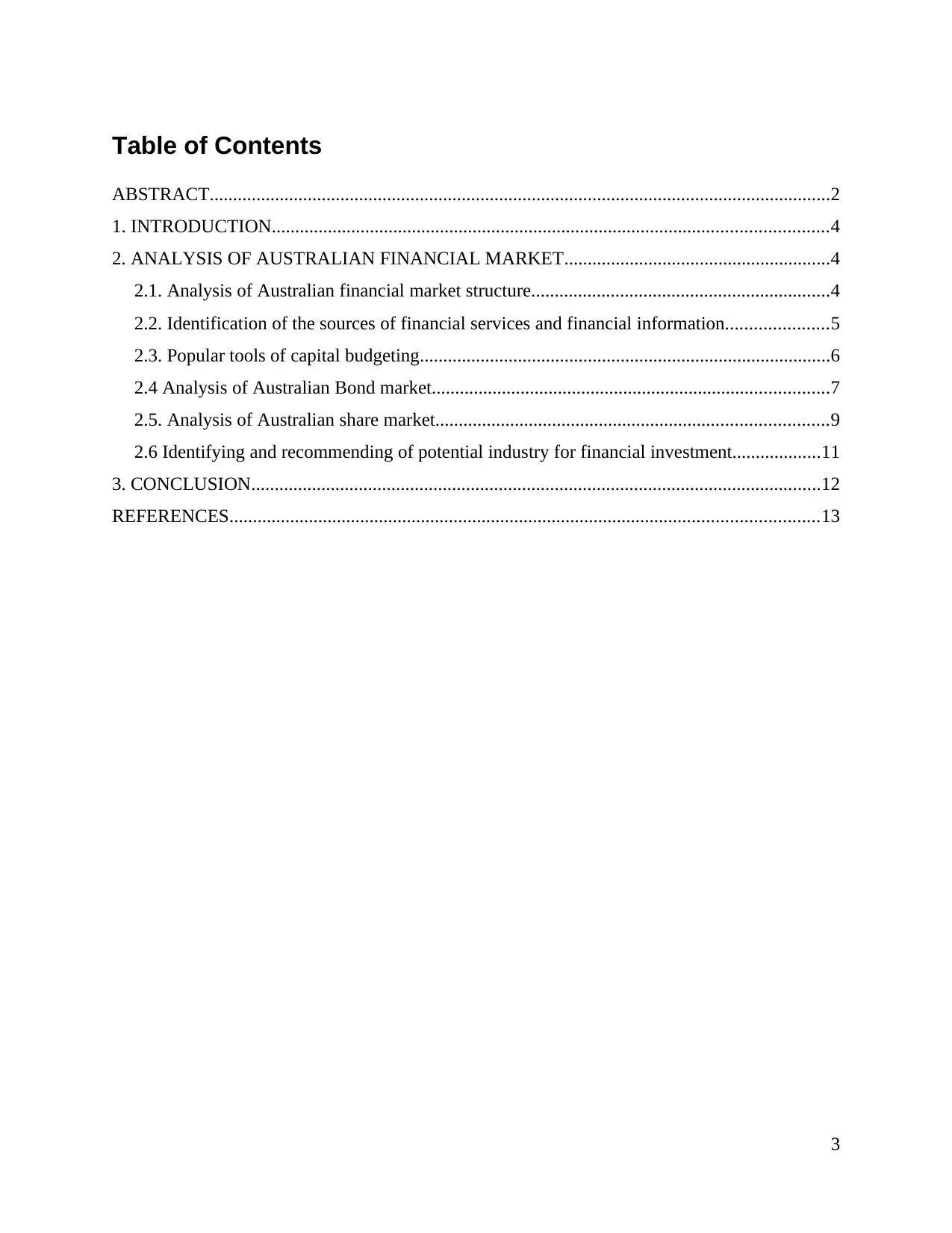
Table of Contents
ABSTRACT.....................................................................................................................................2
1. INTRODUCTION.......................................................................................................................4
2. ANALYSIS OF AUSTRALIAN FINANCIAL MARKET.........................................................4
2.1. Analysis of Australian financial market structure................................................................4
2.2. Identification of the sources of financial services and financial information......................5
2.3. Popular tools of capital budgeting........................................................................................6
2.4 Analysis of Australian Bond market.....................................................................................7
2.5. Analysis of Australian share market....................................................................................9
2.6 Identifying and recommending of potential industry for financial investment...................11
3. CONCLUSION..........................................................................................................................12
REFERENCES..............................................................................................................................13
3
ABSTRACT.....................................................................................................................................2
1. INTRODUCTION.......................................................................................................................4
2. ANALYSIS OF AUSTRALIAN FINANCIAL MARKET.........................................................4
2.1. Analysis of Australian financial market structure................................................................4
2.2. Identification of the sources of financial services and financial information......................5
2.3. Popular tools of capital budgeting........................................................................................6
2.4 Analysis of Australian Bond market.....................................................................................7
2.5. Analysis of Australian share market....................................................................................9
2.6 Identifying and recommending of potential industry for financial investment...................11
3. CONCLUSION..........................................................................................................................12
REFERENCES..............................................................................................................................13
3
⊘ This is a preview!⊘
Do you want full access?
Subscribe today to unlock all pages.

Trusted by 1+ million students worldwide
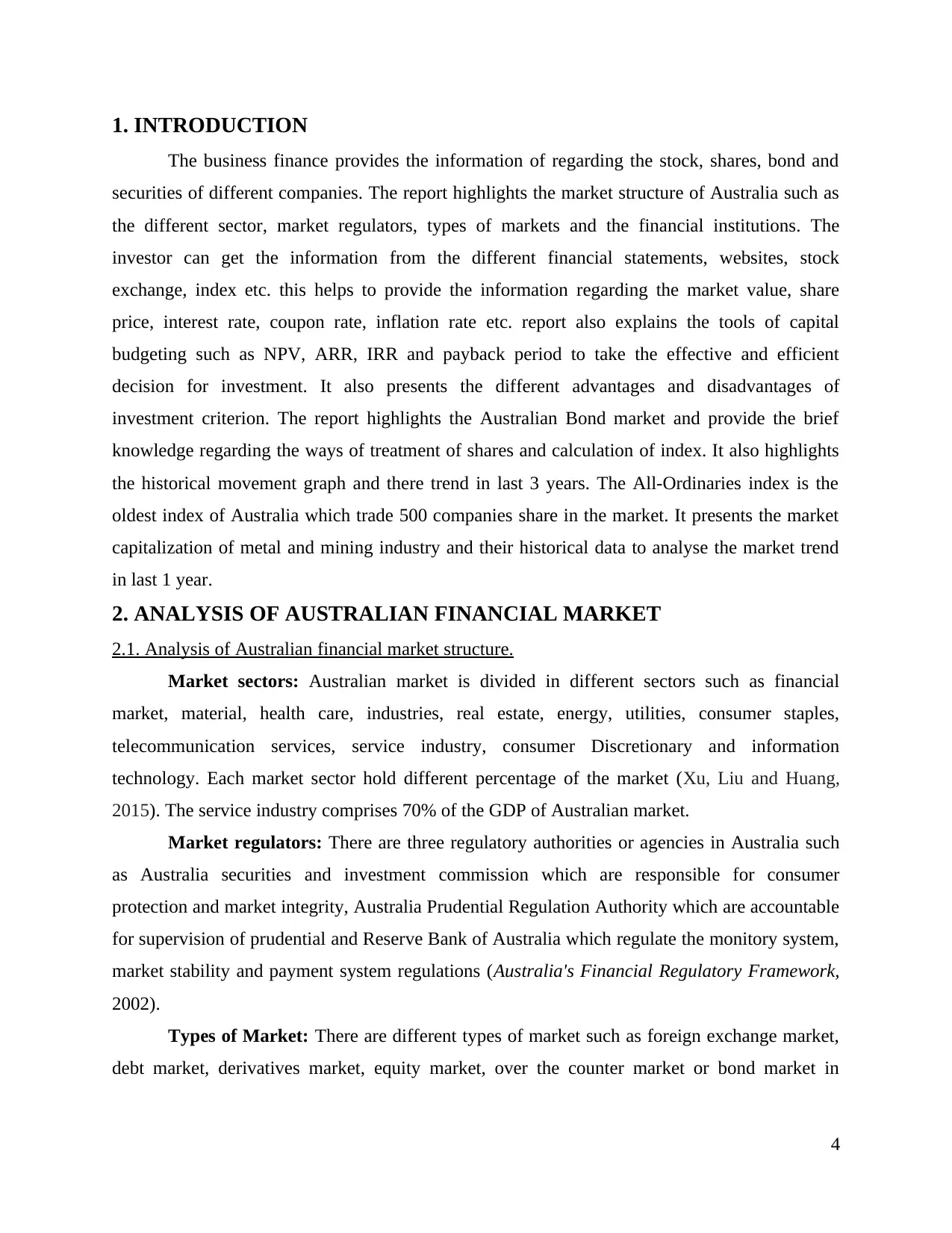
1. INTRODUCTION
The business finance provides the information of regarding the stock, shares, bond and
securities of different companies. The report highlights the market structure of Australia such as
the different sector, market regulators, types of markets and the financial institutions. The
investor can get the information from the different financial statements, websites, stock
exchange, index etc. this helps to provide the information regarding the market value, share
price, interest rate, coupon rate, inflation rate etc. report also explains the tools of capital
budgeting such as NPV, ARR, IRR and payback period to take the effective and efficient
decision for investment. It also presents the different advantages and disadvantages of
investment criterion. The report highlights the Australian Bond market and provide the brief
knowledge regarding the ways of treatment of shares and calculation of index. It also highlights
the historical movement graph and there trend in last 3 years. The All-Ordinaries index is the
oldest index of Australia which trade 500 companies share in the market. It presents the market
capitalization of metal and mining industry and their historical data to analyse the market trend
in last 1 year.
2. ANALYSIS OF AUSTRALIAN FINANCIAL MARKET
2.1. Analysis of Australian financial market structure.
Market sectors: Australian market is divided in different sectors such as financial
market, material, health care, industries, real estate, energy, utilities, consumer staples,
telecommunication services, service industry, consumer Discretionary and information
technology. Each market sector hold different percentage of the market (Xu, Liu and Huang,
2015). The service industry comprises 70% of the GDP of Australian market.
Market regulators: There are three regulatory authorities or agencies in Australia such
as Australia securities and investment commission which are responsible for consumer
protection and market integrity, Australia Prudential Regulation Authority which are accountable
for supervision of prudential and Reserve Bank of Australia which regulate the monitory system,
market stability and payment system regulations (Australia's Financial Regulatory Framework,
2002).
Types of Market: There are different types of market such as foreign exchange market,
debt market, derivatives market, equity market, over the counter market or bond market in
4
The business finance provides the information of regarding the stock, shares, bond and
securities of different companies. The report highlights the market structure of Australia such as
the different sector, market regulators, types of markets and the financial institutions. The
investor can get the information from the different financial statements, websites, stock
exchange, index etc. this helps to provide the information regarding the market value, share
price, interest rate, coupon rate, inflation rate etc. report also explains the tools of capital
budgeting such as NPV, ARR, IRR and payback period to take the effective and efficient
decision for investment. It also presents the different advantages and disadvantages of
investment criterion. The report highlights the Australian Bond market and provide the brief
knowledge regarding the ways of treatment of shares and calculation of index. It also highlights
the historical movement graph and there trend in last 3 years. The All-Ordinaries index is the
oldest index of Australia which trade 500 companies share in the market. It presents the market
capitalization of metal and mining industry and their historical data to analyse the market trend
in last 1 year.
2. ANALYSIS OF AUSTRALIAN FINANCIAL MARKET
2.1. Analysis of Australian financial market structure.
Market sectors: Australian market is divided in different sectors such as financial
market, material, health care, industries, real estate, energy, utilities, consumer staples,
telecommunication services, service industry, consumer Discretionary and information
technology. Each market sector hold different percentage of the market (Xu, Liu and Huang,
2015). The service industry comprises 70% of the GDP of Australian market.
Market regulators: There are three regulatory authorities or agencies in Australia such
as Australia securities and investment commission which are responsible for consumer
protection and market integrity, Australia Prudential Regulation Authority which are accountable
for supervision of prudential and Reserve Bank of Australia which regulate the monitory system,
market stability and payment system regulations (Australia's Financial Regulatory Framework,
2002).
Types of Market: There are different types of market such as foreign exchange market,
debt market, derivatives market, equity market, over the counter market or bond market in
4
Paraphrase This Document
Need a fresh take? Get an instant paraphrase of this document with our AI Paraphraser
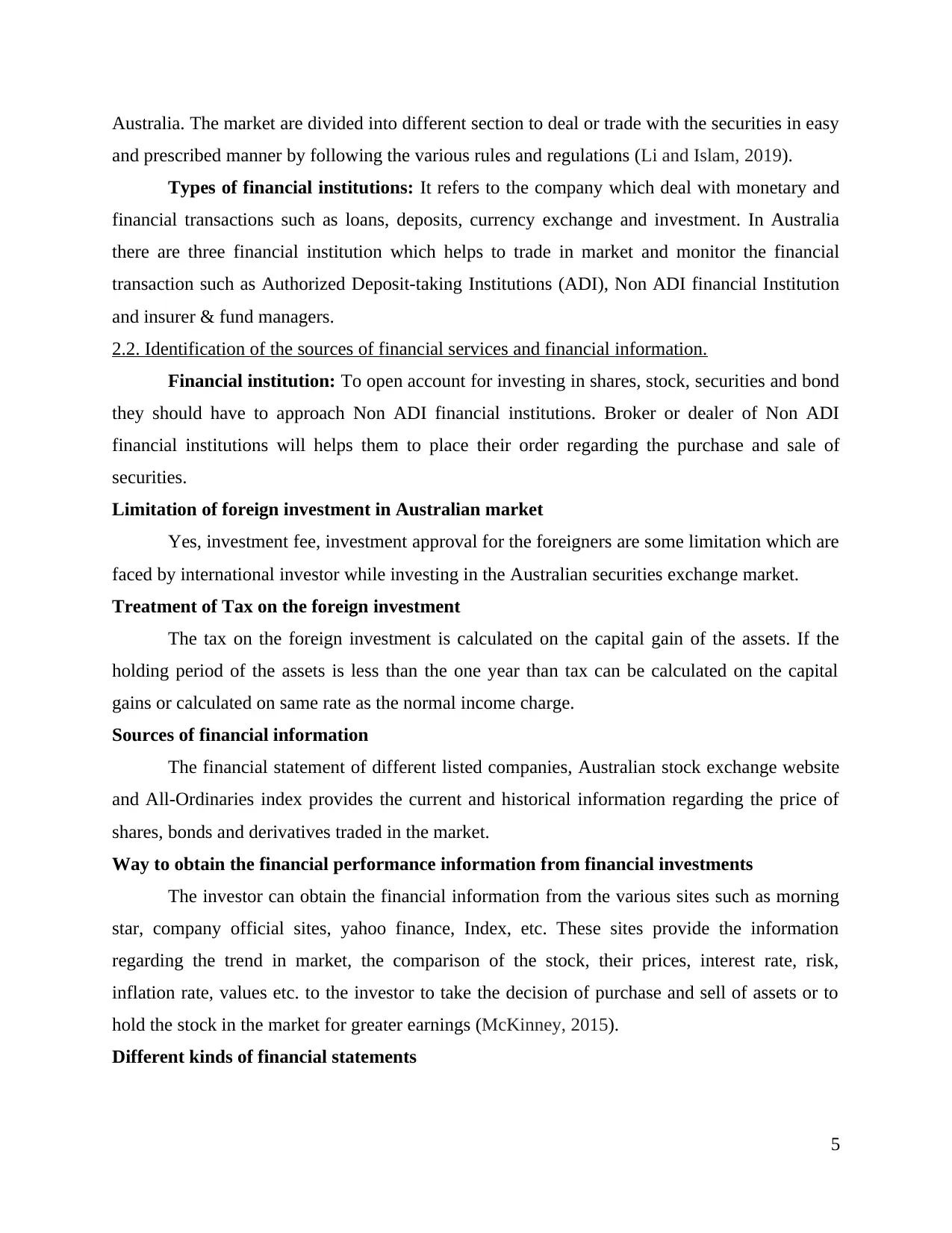
Australia. The market are divided into different section to deal or trade with the securities in easy
and prescribed manner by following the various rules and regulations (Li and Islam, 2019).
Types of financial institutions: It refers to the company which deal with monetary and
financial transactions such as loans, deposits, currency exchange and investment. In Australia
there are three financial institution which helps to trade in market and monitor the financial
transaction such as Authorized Deposit-taking Institutions (ADI), Non ADI financial Institution
and insurer & fund managers.
2.2. Identification of the sources of financial services and financial information.
Financial institution: To open account for investing in shares, stock, securities and bond
they should have to approach Non ADI financial institutions. Broker or dealer of Non ADI
financial institutions will helps them to place their order regarding the purchase and sale of
securities.
Limitation of foreign investment in Australian market
Yes, investment fee, investment approval for the foreigners are some limitation which are
faced by international investor while investing in the Australian securities exchange market.
Treatment of Tax on the foreign investment
The tax on the foreign investment is calculated on the capital gain of the assets. If the
holding period of the assets is less than the one year than tax can be calculated on the capital
gains or calculated on same rate as the normal income charge.
Sources of financial information
The financial statement of different listed companies, Australian stock exchange website
and All-Ordinaries index provides the current and historical information regarding the price of
shares, bonds and derivatives traded in the market.
Way to obtain the financial performance information from financial investments
The investor can obtain the financial information from the various sites such as morning
star, company official sites, yahoo finance, Index, etc. These sites provide the information
regarding the trend in market, the comparison of the stock, their prices, interest rate, risk,
inflation rate, values etc. to the investor to take the decision of purchase and sell of assets or to
hold the stock in the market for greater earnings (McKinney, 2015).
Different kinds of financial statements
5
and prescribed manner by following the various rules and regulations (Li and Islam, 2019).
Types of financial institutions: It refers to the company which deal with monetary and
financial transactions such as loans, deposits, currency exchange and investment. In Australia
there are three financial institution which helps to trade in market and monitor the financial
transaction such as Authorized Deposit-taking Institutions (ADI), Non ADI financial Institution
and insurer & fund managers.
2.2. Identification of the sources of financial services and financial information.
Financial institution: To open account for investing in shares, stock, securities and bond
they should have to approach Non ADI financial institutions. Broker or dealer of Non ADI
financial institutions will helps them to place their order regarding the purchase and sale of
securities.
Limitation of foreign investment in Australian market
Yes, investment fee, investment approval for the foreigners are some limitation which are
faced by international investor while investing in the Australian securities exchange market.
Treatment of Tax on the foreign investment
The tax on the foreign investment is calculated on the capital gain of the assets. If the
holding period of the assets is less than the one year than tax can be calculated on the capital
gains or calculated on same rate as the normal income charge.
Sources of financial information
The financial statement of different listed companies, Australian stock exchange website
and All-Ordinaries index provides the current and historical information regarding the price of
shares, bonds and derivatives traded in the market.
Way to obtain the financial performance information from financial investments
The investor can obtain the financial information from the various sites such as morning
star, company official sites, yahoo finance, Index, etc. These sites provide the information
regarding the trend in market, the comparison of the stock, their prices, interest rate, risk,
inflation rate, values etc. to the investor to take the decision of purchase and sell of assets or to
hold the stock in the market for greater earnings (McKinney, 2015).
Different kinds of financial statements
5
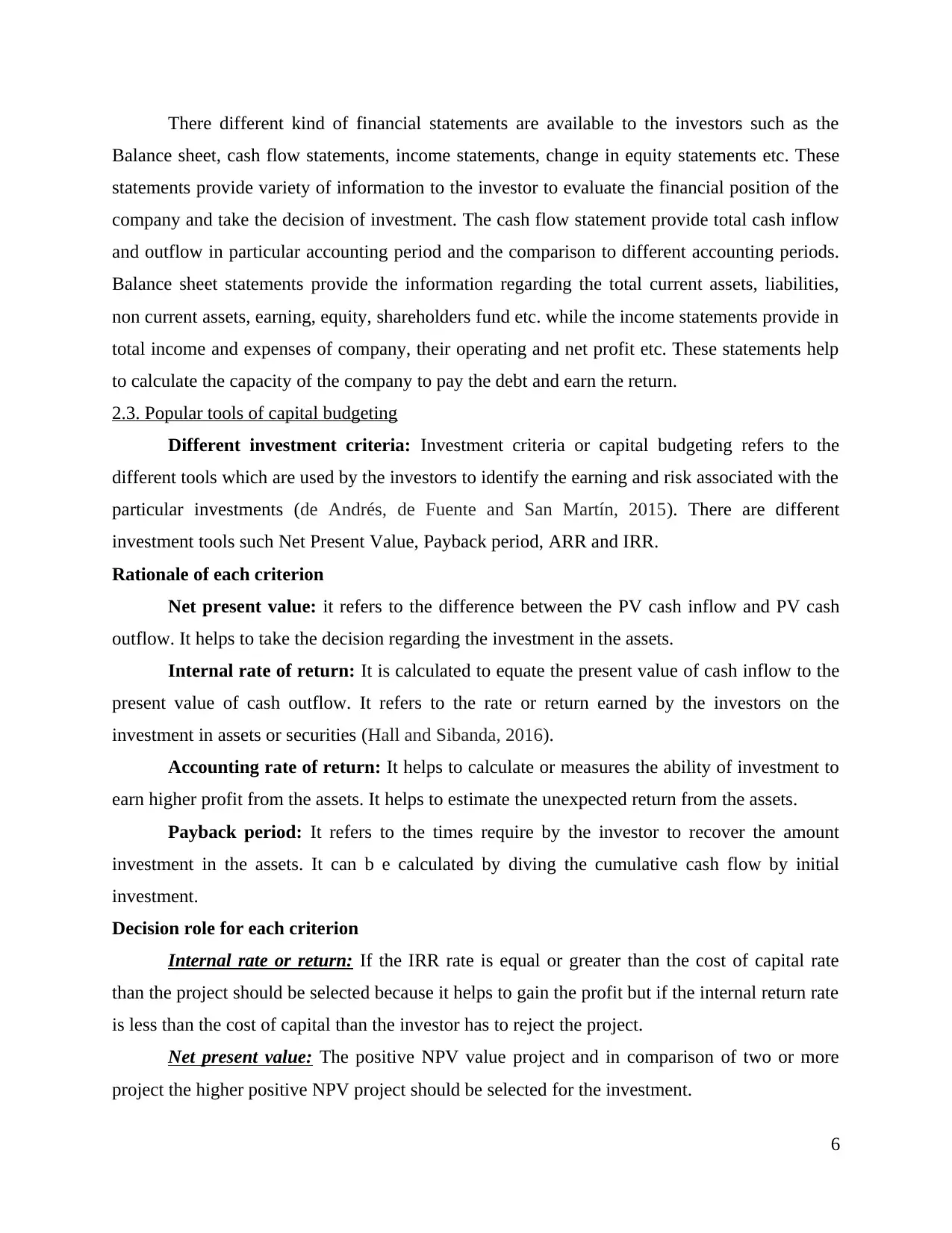
There different kind of financial statements are available to the investors such as the
Balance sheet, cash flow statements, income statements, change in equity statements etc. These
statements provide variety of information to the investor to evaluate the financial position of the
company and take the decision of investment. The cash flow statement provide total cash inflow
and outflow in particular accounting period and the comparison to different accounting periods.
Balance sheet statements provide the information regarding the total current assets, liabilities,
non current assets, earning, equity, shareholders fund etc. while the income statements provide in
total income and expenses of company, their operating and net profit etc. These statements help
to calculate the capacity of the company to pay the debt and earn the return.
2.3. Popular tools of capital budgeting
Different investment criteria: Investment criteria or capital budgeting refers to the
different tools which are used by the investors to identify the earning and risk associated with the
particular investments (de Andrés, de Fuente and San Martín, 2015). There are different
investment tools such Net Present Value, Payback period, ARR and IRR.
Rationale of each criterion
Net present value: it refers to the difference between the PV cash inflow and PV cash
outflow. It helps to take the decision regarding the investment in the assets.
Internal rate of return: It is calculated to equate the present value of cash inflow to the
present value of cash outflow. It refers to the rate or return earned by the investors on the
investment in assets or securities (Hall and Sibanda, 2016).
Accounting rate of return: It helps to calculate or measures the ability of investment to
earn higher profit from the assets. It helps to estimate the unexpected return from the assets.
Payback period: It refers to the times require by the investor to recover the amount
investment in the assets. It can b e calculated by diving the cumulative cash flow by initial
investment.
Decision role for each criterion
Internal rate or return: If the IRR rate is equal or greater than the cost of capital rate
than the project should be selected because it helps to gain the profit but if the internal return rate
is less than the cost of capital than the investor has to reject the project.
Net present value: The positive NPV value project and in comparison of two or more
project the higher positive NPV project should be selected for the investment.
6
Balance sheet, cash flow statements, income statements, change in equity statements etc. These
statements provide variety of information to the investor to evaluate the financial position of the
company and take the decision of investment. The cash flow statement provide total cash inflow
and outflow in particular accounting period and the comparison to different accounting periods.
Balance sheet statements provide the information regarding the total current assets, liabilities,
non current assets, earning, equity, shareholders fund etc. while the income statements provide in
total income and expenses of company, their operating and net profit etc. These statements help
to calculate the capacity of the company to pay the debt and earn the return.
2.3. Popular tools of capital budgeting
Different investment criteria: Investment criteria or capital budgeting refers to the
different tools which are used by the investors to identify the earning and risk associated with the
particular investments (de Andrés, de Fuente and San Martín, 2015). There are different
investment tools such Net Present Value, Payback period, ARR and IRR.
Rationale of each criterion
Net present value: it refers to the difference between the PV cash inflow and PV cash
outflow. It helps to take the decision regarding the investment in the assets.
Internal rate of return: It is calculated to equate the present value of cash inflow to the
present value of cash outflow. It refers to the rate or return earned by the investors on the
investment in assets or securities (Hall and Sibanda, 2016).
Accounting rate of return: It helps to calculate or measures the ability of investment to
earn higher profit from the assets. It helps to estimate the unexpected return from the assets.
Payback period: It refers to the times require by the investor to recover the amount
investment in the assets. It can b e calculated by diving the cumulative cash flow by initial
investment.
Decision role for each criterion
Internal rate or return: If the IRR rate is equal or greater than the cost of capital rate
than the project should be selected because it helps to gain the profit but if the internal return rate
is less than the cost of capital than the investor has to reject the project.
Net present value: The positive NPV value project and in comparison of two or more
project the higher positive NPV project should be selected for the investment.
6
⊘ This is a preview!⊘
Do you want full access?
Subscribe today to unlock all pages.

Trusted by 1+ million students worldwide
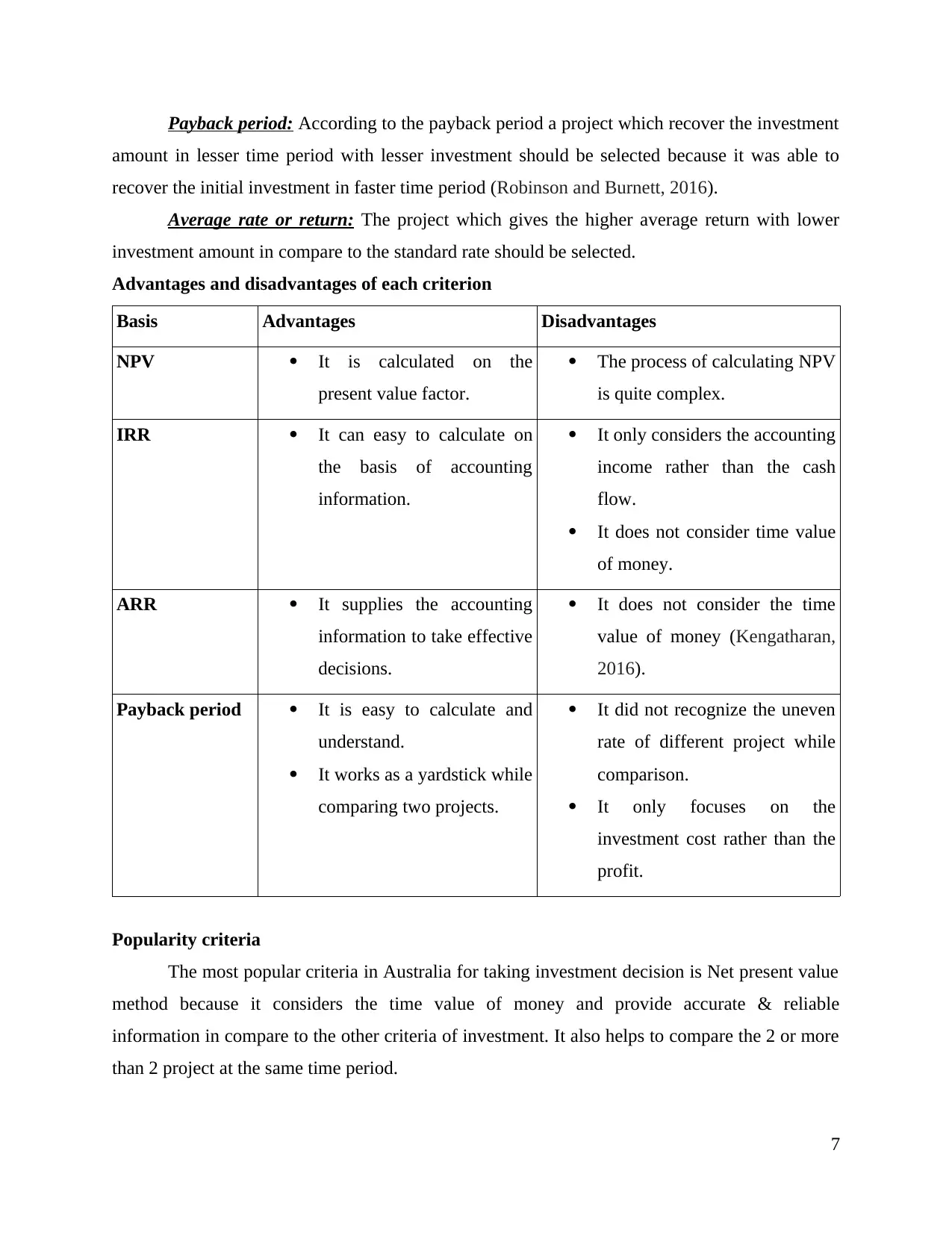
Payback period: According to the payback period a project which recover the investment
amount in lesser time period with lesser investment should be selected because it was able to
recover the initial investment in faster time period (Robinson and Burnett, 2016).
Average rate or return: The project which gives the higher average return with lower
investment amount in compare to the standard rate should be selected.
Advantages and disadvantages of each criterion
Basis Advantages Disadvantages
NPV It is calculated on the
present value factor.
The process of calculating NPV
is quite complex.
IRR It can easy to calculate on
the basis of accounting
information.
It only considers the accounting
income rather than the cash
flow.
It does not consider time value
of money.
ARR It supplies the accounting
information to take effective
decisions.
It does not consider the time
value of money (Kengatharan,
2016).
Payback period It is easy to calculate and
understand.
It works as a yardstick while
comparing two projects.
It did not recognize the uneven
rate of different project while
comparison.
It only focuses on the
investment cost rather than the
profit.
Popularity criteria
The most popular criteria in Australia for taking investment decision is Net present value
method because it considers the time value of money and provide accurate & reliable
information in compare to the other criteria of investment. It also helps to compare the 2 or more
than 2 project at the same time period.
7
amount in lesser time period with lesser investment should be selected because it was able to
recover the initial investment in faster time period (Robinson and Burnett, 2016).
Average rate or return: The project which gives the higher average return with lower
investment amount in compare to the standard rate should be selected.
Advantages and disadvantages of each criterion
Basis Advantages Disadvantages
NPV It is calculated on the
present value factor.
The process of calculating NPV
is quite complex.
IRR It can easy to calculate on
the basis of accounting
information.
It only considers the accounting
income rather than the cash
flow.
It does not consider time value
of money.
ARR It supplies the accounting
information to take effective
decisions.
It does not consider the time
value of money (Kengatharan,
2016).
Payback period It is easy to calculate and
understand.
It works as a yardstick while
comparing two projects.
It did not recognize the uneven
rate of different project while
comparison.
It only focuses on the
investment cost rather than the
profit.
Popularity criteria
The most popular criteria in Australia for taking investment decision is Net present value
method because it considers the time value of money and provide accurate & reliable
information in compare to the other criteria of investment. It also helps to compare the 2 or more
than 2 project at the same time period.
7
Paraphrase This Document
Need a fresh take? Get an instant paraphrase of this document with our AI Paraphraser
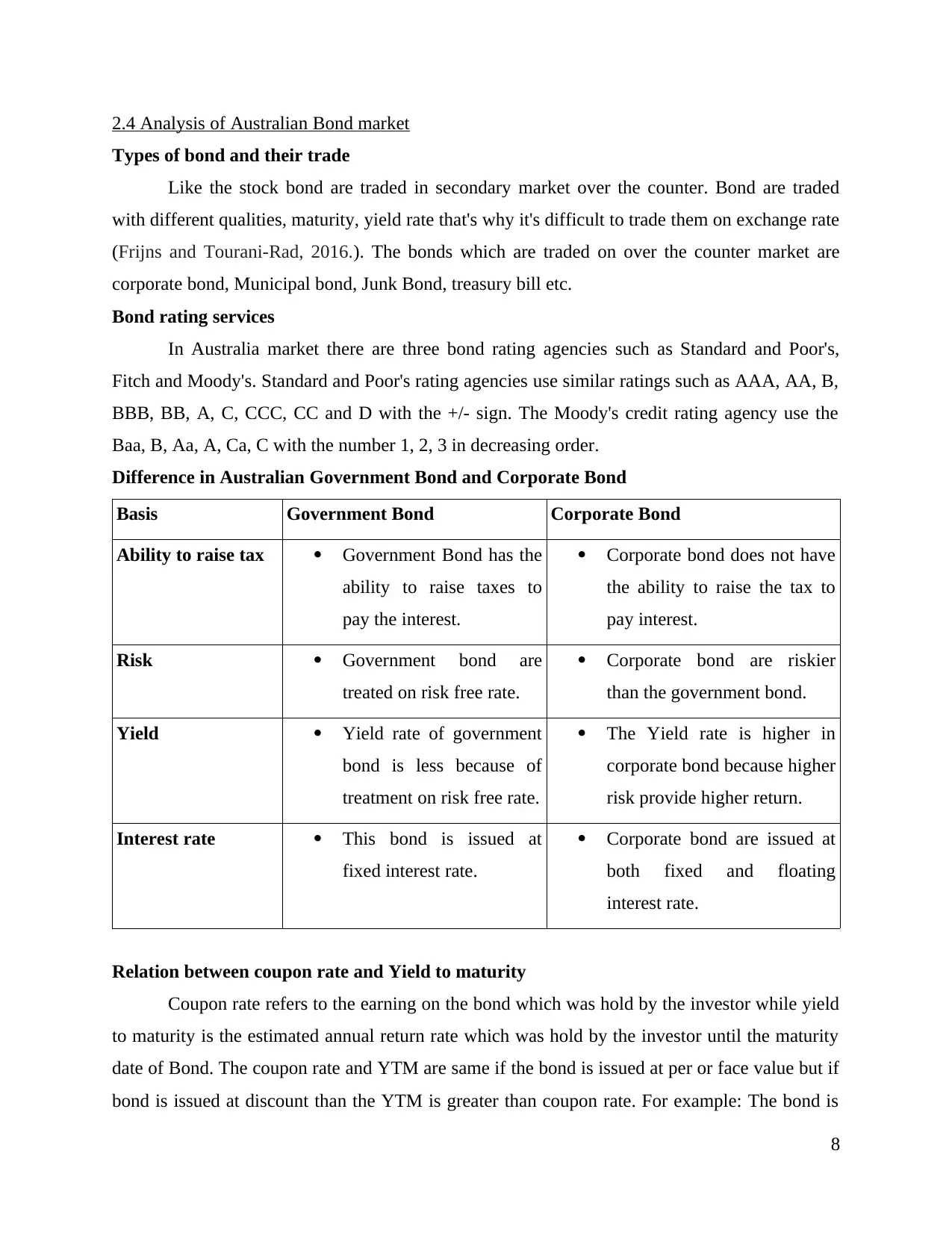
2.4 Analysis of Australian Bond market
Types of bond and their trade
Like the stock bond are traded in secondary market over the counter. Bond are traded
with different qualities, maturity, yield rate that's why it's difficult to trade them on exchange rate
(Frijns and Tourani-Rad, 2016.). The bonds which are traded on over the counter market are
corporate bond, Municipal bond, Junk Bond, treasury bill etc.
Bond rating services
In Australia market there are three bond rating agencies such as Standard and Poor's,
Fitch and Moody's. Standard and Poor's rating agencies use similar ratings such as AAA, AA, B,
BBB, BB, A, C, CCC, CC and D with the +/- sign. The Moody's credit rating agency use the
Baa, B, Aa, A, Ca, C with the number 1, 2, 3 in decreasing order.
Difference in Australian Government Bond and Corporate Bond
Basis Government Bond Corporate Bond
Ability to raise tax Government Bond has the
ability to raise taxes to
pay the interest.
Corporate bond does not have
the ability to raise the tax to
pay interest.
Risk Government bond are
treated on risk free rate.
Corporate bond are riskier
than the government bond.
Yield Yield rate of government
bond is less because of
treatment on risk free rate.
The Yield rate is higher in
corporate bond because higher
risk provide higher return.
Interest rate This bond is issued at
fixed interest rate.
Corporate bond are issued at
both fixed and floating
interest rate.
Relation between coupon rate and Yield to maturity
Coupon rate refers to the earning on the bond which was hold by the investor while yield
to maturity is the estimated annual return rate which was hold by the investor until the maturity
date of Bond. The coupon rate and YTM are same if the bond is issued at per or face value but if
bond is issued at discount than the YTM is greater than coupon rate. For example: The bond is
8
Types of bond and their trade
Like the stock bond are traded in secondary market over the counter. Bond are traded
with different qualities, maturity, yield rate that's why it's difficult to trade them on exchange rate
(Frijns and Tourani-Rad, 2016.). The bonds which are traded on over the counter market are
corporate bond, Municipal bond, Junk Bond, treasury bill etc.
Bond rating services
In Australia market there are three bond rating agencies such as Standard and Poor's,
Fitch and Moody's. Standard and Poor's rating agencies use similar ratings such as AAA, AA, B,
BBB, BB, A, C, CCC, CC and D with the +/- sign. The Moody's credit rating agency use the
Baa, B, Aa, A, Ca, C with the number 1, 2, 3 in decreasing order.
Difference in Australian Government Bond and Corporate Bond
Basis Government Bond Corporate Bond
Ability to raise tax Government Bond has the
ability to raise taxes to
pay the interest.
Corporate bond does not have
the ability to raise the tax to
pay interest.
Risk Government bond are
treated on risk free rate.
Corporate bond are riskier
than the government bond.
Yield Yield rate of government
bond is less because of
treatment on risk free rate.
The Yield rate is higher in
corporate bond because higher
risk provide higher return.
Interest rate This bond is issued at
fixed interest rate.
Corporate bond are issued at
both fixed and floating
interest rate.
Relation between coupon rate and Yield to maturity
Coupon rate refers to the earning on the bond which was hold by the investor while yield
to maturity is the estimated annual return rate which was hold by the investor until the maturity
date of Bond. The coupon rate and YTM are same if the bond is issued at per or face value but if
bond is issued at discount than the YTM is greater than coupon rate. For example: The bond is
8
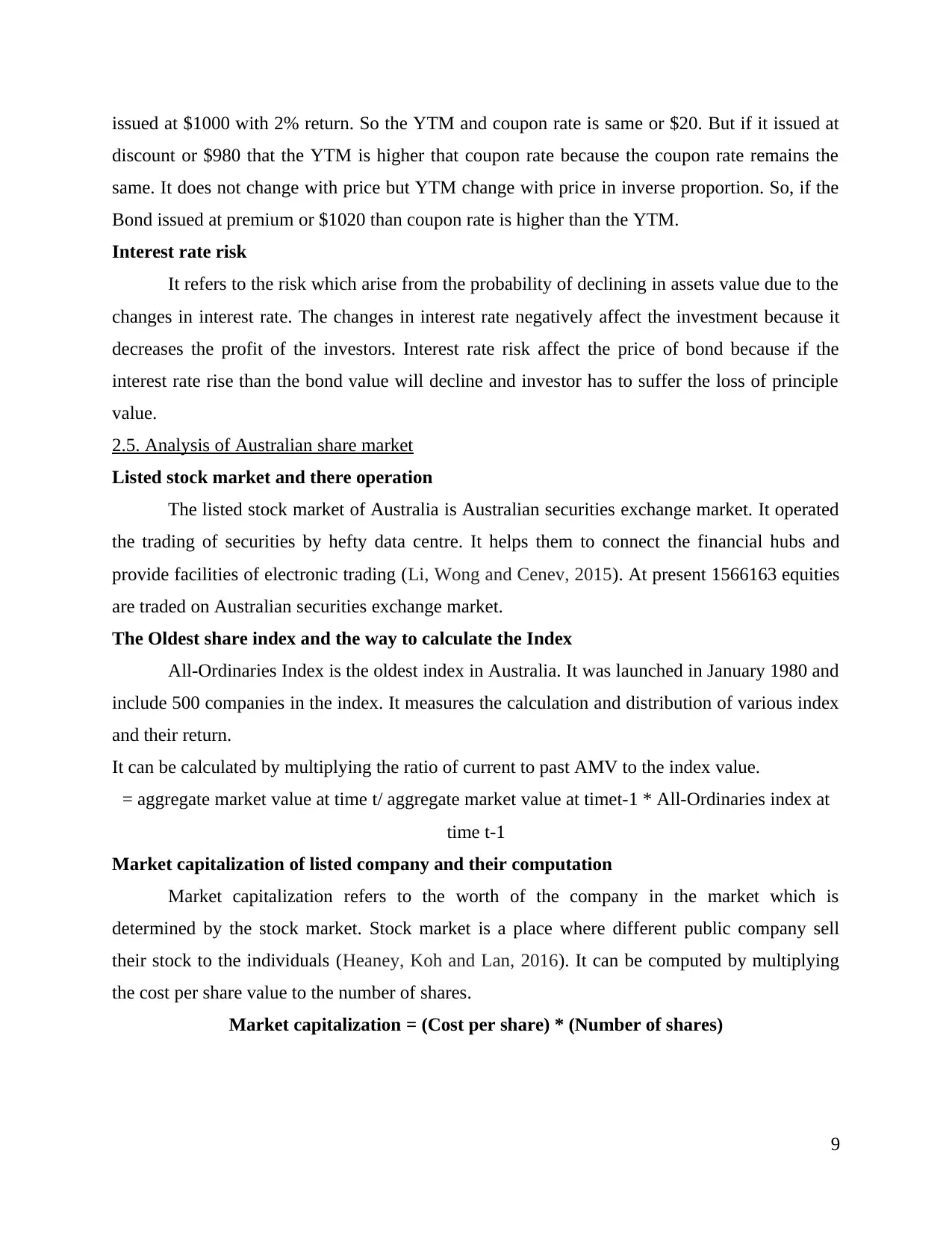
issued at $1000 with 2% return. So the YTM and coupon rate is same or $20. But if it issued at
discount or $980 that the YTM is higher that coupon rate because the coupon rate remains the
same. It does not change with price but YTM change with price in inverse proportion. So, if the
Bond issued at premium or $1020 than coupon rate is higher than the YTM.
Interest rate risk
It refers to the risk which arise from the probability of declining in assets value due to the
changes in interest rate. The changes in interest rate negatively affect the investment because it
decreases the profit of the investors. Interest rate risk affect the price of bond because if the
interest rate rise than the bond value will decline and investor has to suffer the loss of principle
value.
2.5. Analysis of Australian share market
Listed stock market and there operation
The listed stock market of Australia is Australian securities exchange market. It operated
the trading of securities by hefty data centre. It helps them to connect the financial hubs and
provide facilities of electronic trading (Li, Wong and Cenev, 2015). At present 1566163 equities
are traded on Australian securities exchange market.
The Oldest share index and the way to calculate the Index
All-Ordinaries Index is the oldest index in Australia. It was launched in January 1980 and
include 500 companies in the index. It measures the calculation and distribution of various index
and their return.
It can be calculated by multiplying the ratio of current to past AMV to the index value.
= aggregate market value at time t/ aggregate market value at timet-1 * All-Ordinaries index at
time t-1
Market capitalization of listed company and their computation
Market capitalization refers to the worth of the company in the market which is
determined by the stock market. Stock market is a place where different public company sell
their stock to the individuals (Heaney, Koh and Lan, 2016). It can be computed by multiplying
the cost per share value to the number of shares.
Market capitalization = (Cost per share) * (Number of shares)
9
discount or $980 that the YTM is higher that coupon rate because the coupon rate remains the
same. It does not change with price but YTM change with price in inverse proportion. So, if the
Bond issued at premium or $1020 than coupon rate is higher than the YTM.
Interest rate risk
It refers to the risk which arise from the probability of declining in assets value due to the
changes in interest rate. The changes in interest rate negatively affect the investment because it
decreases the profit of the investors. Interest rate risk affect the price of bond because if the
interest rate rise than the bond value will decline and investor has to suffer the loss of principle
value.
2.5. Analysis of Australian share market
Listed stock market and there operation
The listed stock market of Australia is Australian securities exchange market. It operated
the trading of securities by hefty data centre. It helps them to connect the financial hubs and
provide facilities of electronic trading (Li, Wong and Cenev, 2015). At present 1566163 equities
are traded on Australian securities exchange market.
The Oldest share index and the way to calculate the Index
All-Ordinaries Index is the oldest index in Australia. It was launched in January 1980 and
include 500 companies in the index. It measures the calculation and distribution of various index
and their return.
It can be calculated by multiplying the ratio of current to past AMV to the index value.
= aggregate market value at time t/ aggregate market value at timet-1 * All-Ordinaries index at
time t-1
Market capitalization of listed company and their computation
Market capitalization refers to the worth of the company in the market which is
determined by the stock market. Stock market is a place where different public company sell
their stock to the individuals (Heaney, Koh and Lan, 2016). It can be computed by multiplying
the cost per share value to the number of shares.
Market capitalization = (Cost per share) * (Number of shares)
9
⊘ This is a preview!⊘
Do you want full access?
Subscribe today to unlock all pages.

Trusted by 1+ million students worldwide
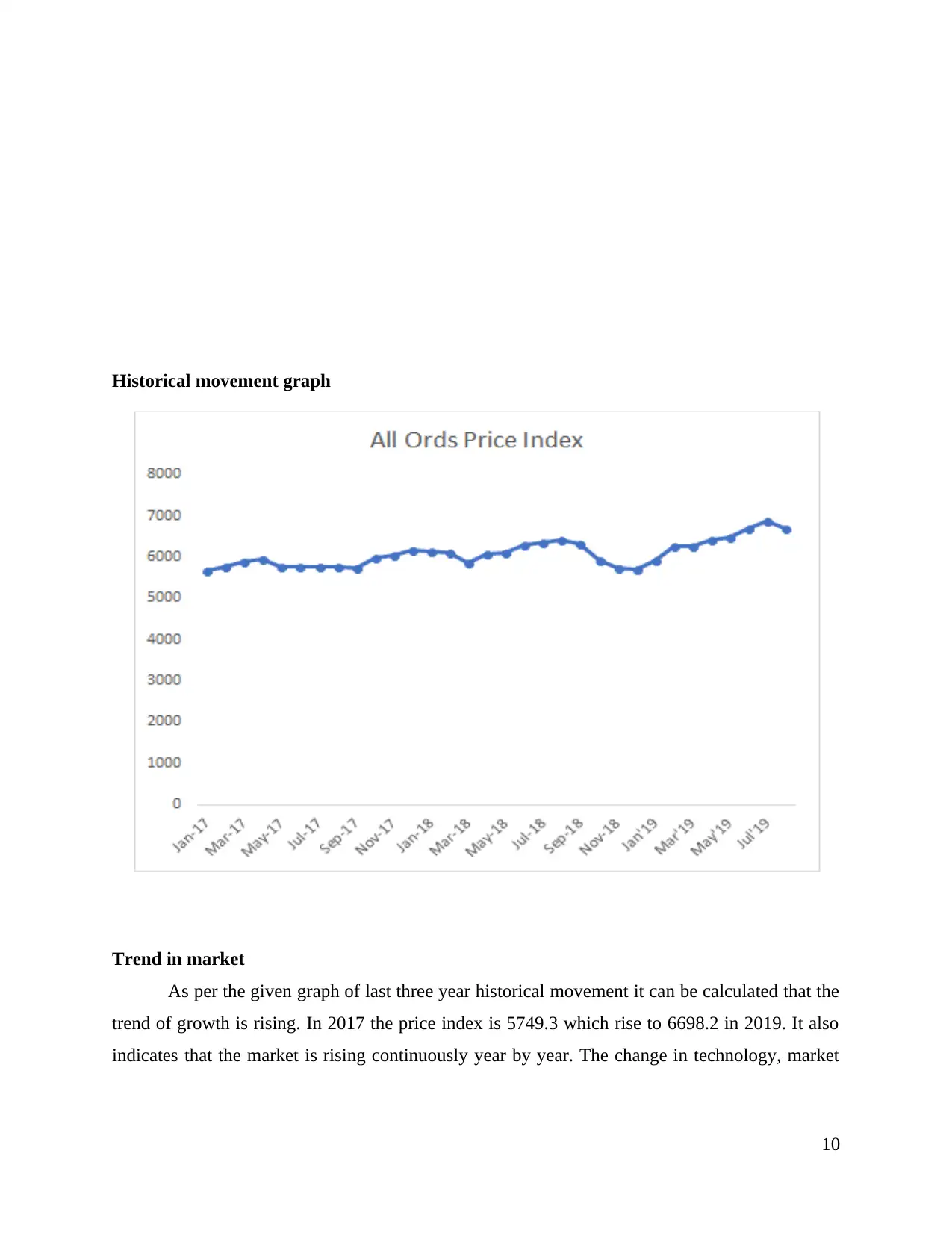
Historical movement graph
Trend in market
As per the given graph of last three year historical movement it can be calculated that the
trend of growth is rising. In 2017 the price index is 5749.3 which rise to 6698.2 in 2019. It also
indicates that the market is rising continuously year by year. The change in technology, market
10
Trend in market
As per the given graph of last three year historical movement it can be calculated that the
trend of growth is rising. In 2017 the price index is 5749.3 which rise to 6698.2 in 2019. It also
indicates that the market is rising continuously year by year. The change in technology, market
10
Paraphrase This Document
Need a fresh take? Get an instant paraphrase of this document with our AI Paraphraser
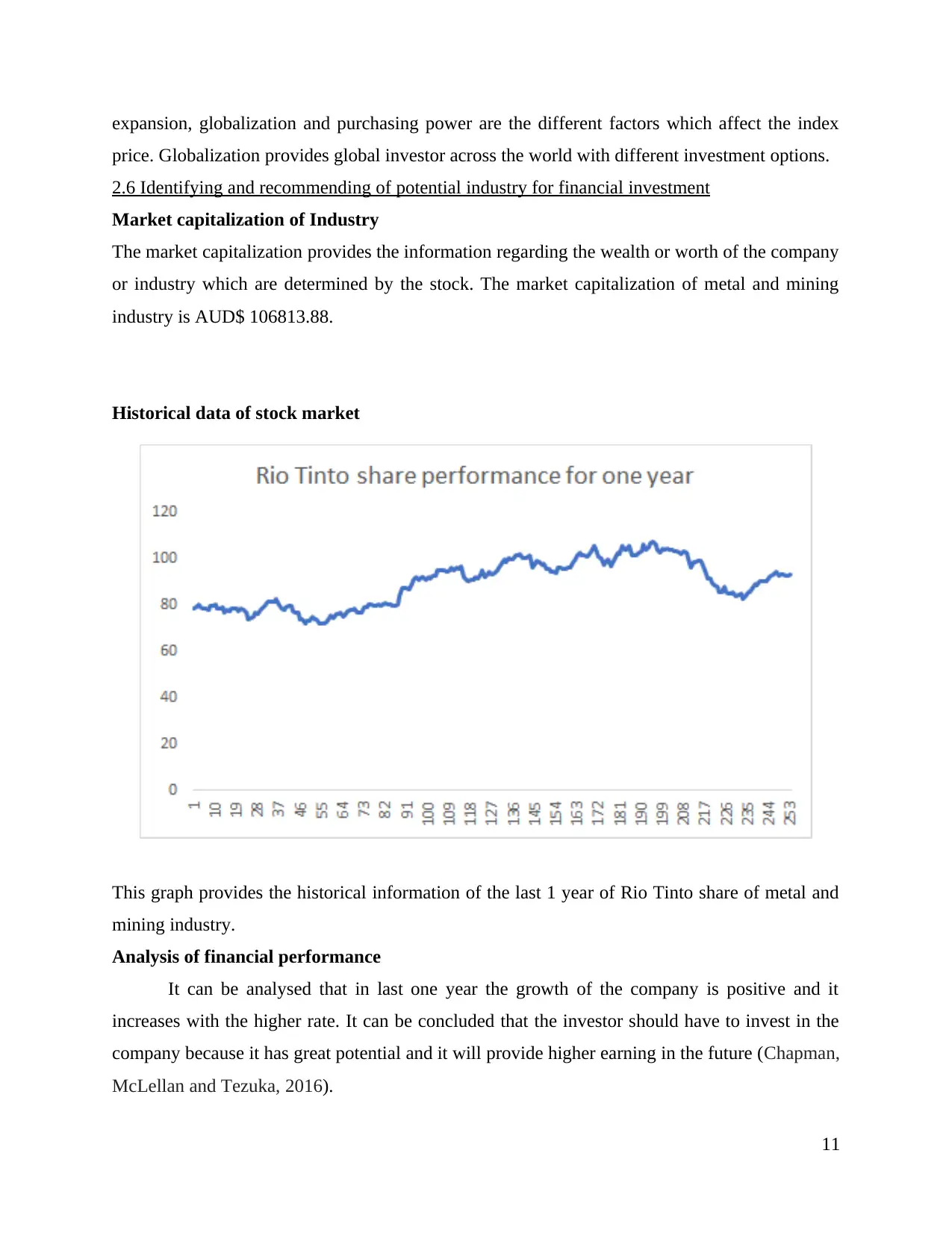
expansion, globalization and purchasing power are the different factors which affect the index
price. Globalization provides global investor across the world with different investment options.
2.6 Identifying and recommending of potential industry for financial investment
Market capitalization of Industry
The market capitalization provides the information regarding the wealth or worth of the company
or industry which are determined by the stock. The market capitalization of metal and mining
industry is AUD$ 106813.88.
Historical data of stock market
This graph provides the historical information of the last 1 year of Rio Tinto share of metal and
mining industry.
Analysis of financial performance
It can be analysed that in last one year the growth of the company is positive and it
increases with the higher rate. It can be concluded that the investor should have to invest in the
company because it has great potential and it will provide higher earning in the future (Chapman,
McLellan and Tezuka, 2016).
11
price. Globalization provides global investor across the world with different investment options.
2.6 Identifying and recommending of potential industry for financial investment
Market capitalization of Industry
The market capitalization provides the information regarding the wealth or worth of the company
or industry which are determined by the stock. The market capitalization of metal and mining
industry is AUD$ 106813.88.
Historical data of stock market
This graph provides the historical information of the last 1 year of Rio Tinto share of metal and
mining industry.
Analysis of financial performance
It can be analysed that in last one year the growth of the company is positive and it
increases with the higher rate. It can be concluded that the investor should have to invest in the
company because it has great potential and it will provide higher earning in the future (Chapman,
McLellan and Tezuka, 2016).
11
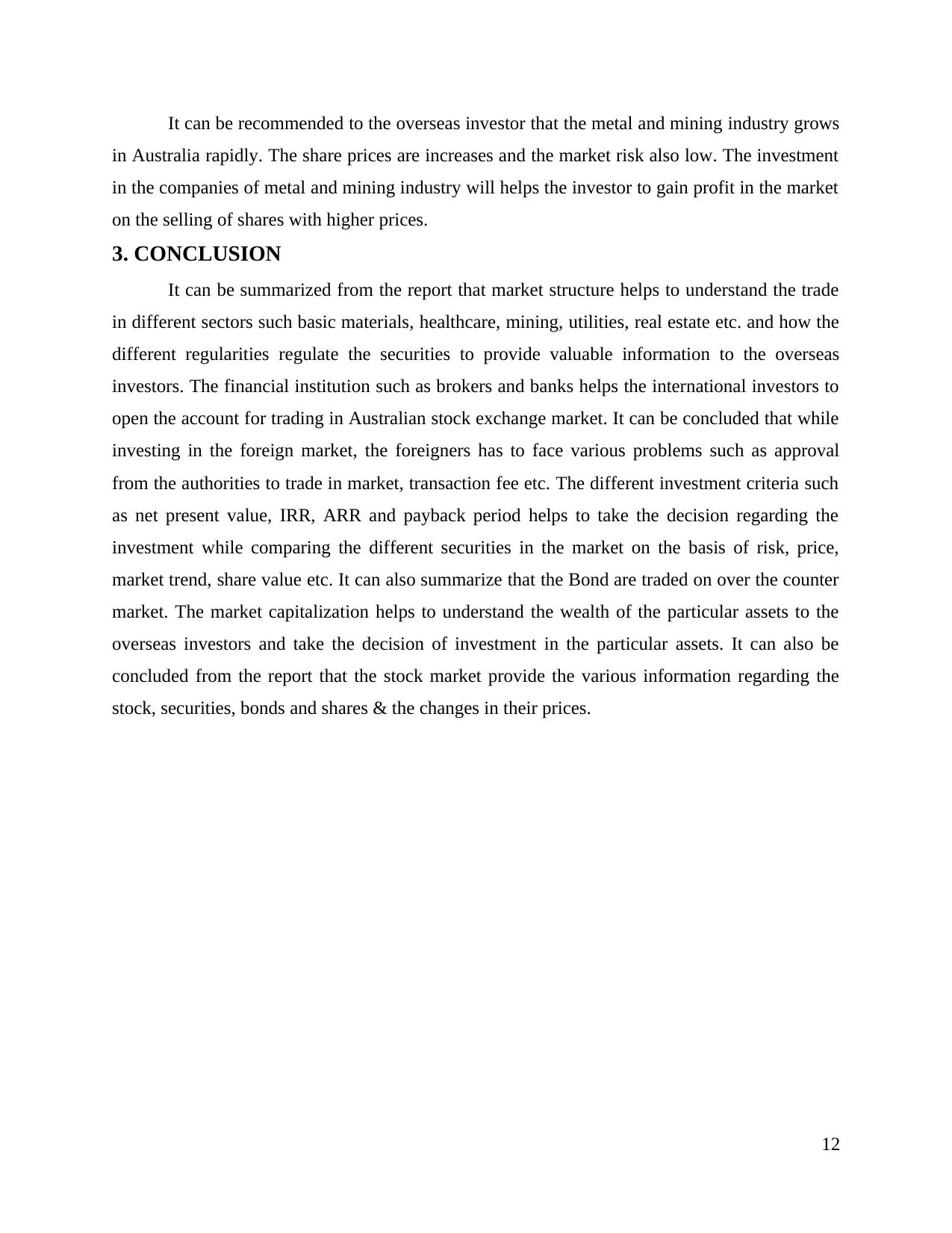
It can be recommended to the overseas investor that the metal and mining industry grows
in Australia rapidly. The share prices are increases and the market risk also low. The investment
in the companies of metal and mining industry will helps the investor to gain profit in the market
on the selling of shares with higher prices.
3. CONCLUSION
It can be summarized from the report that market structure helps to understand the trade
in different sectors such basic materials, healthcare, mining, utilities, real estate etc. and how the
different regularities regulate the securities to provide valuable information to the overseas
investors. The financial institution such as brokers and banks helps the international investors to
open the account for trading in Australian stock exchange market. It can be concluded that while
investing in the foreign market, the foreigners has to face various problems such as approval
from the authorities to trade in market, transaction fee etc. The different investment criteria such
as net present value, IRR, ARR and payback period helps to take the decision regarding the
investment while comparing the different securities in the market on the basis of risk, price,
market trend, share value etc. It can also summarize that the Bond are traded on over the counter
market. The market capitalization helps to understand the wealth of the particular assets to the
overseas investors and take the decision of investment in the particular assets. It can also be
concluded from the report that the stock market provide the various information regarding the
stock, securities, bonds and shares & the changes in their prices.
12
in Australia rapidly. The share prices are increases and the market risk also low. The investment
in the companies of metal and mining industry will helps the investor to gain profit in the market
on the selling of shares with higher prices.
3. CONCLUSION
It can be summarized from the report that market structure helps to understand the trade
in different sectors such basic materials, healthcare, mining, utilities, real estate etc. and how the
different regularities regulate the securities to provide valuable information to the overseas
investors. The financial institution such as brokers and banks helps the international investors to
open the account for trading in Australian stock exchange market. It can be concluded that while
investing in the foreign market, the foreigners has to face various problems such as approval
from the authorities to trade in market, transaction fee etc. The different investment criteria such
as net present value, IRR, ARR and payback period helps to take the decision regarding the
investment while comparing the different securities in the market on the basis of risk, price,
market trend, share value etc. It can also summarize that the Bond are traded on over the counter
market. The market capitalization helps to understand the wealth of the particular assets to the
overseas investors and take the decision of investment in the particular assets. It can also be
concluded from the report that the stock market provide the various information regarding the
stock, securities, bonds and shares & the changes in their prices.
12
⊘ This is a preview!⊘
Do you want full access?
Subscribe today to unlock all pages.

Trusted by 1+ million students worldwide
1 out of 16
Related Documents
Your All-in-One AI-Powered Toolkit for Academic Success.
+13062052269
info@desklib.com
Available 24*7 on WhatsApp / Email
![[object Object]](/_next/static/media/star-bottom.7253800d.svg)
Unlock your academic potential
Copyright © 2020–2025 A2Z Services. All Rights Reserved. Developed and managed by ZUCOL.





